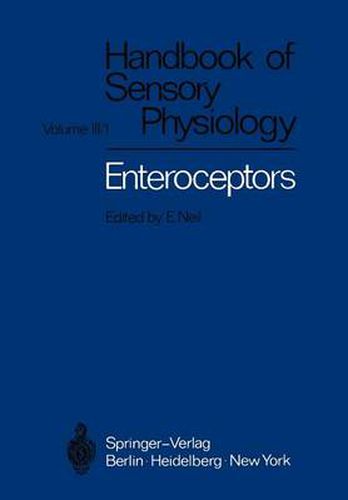Readings Newsletter
Become a Readings Member to make your shopping experience even easier.
Sign in or sign up for free!
You’re not far away from qualifying for FREE standard shipping within Australia
You’ve qualified for FREE standard shipping within Australia
The cart is loading…






This title is printed to order. This book may have been self-published. If so, we cannot guarantee the quality of the content. In the main most books will have gone through the editing process however some may not. We therefore suggest that you be aware of this before ordering this book. If in doubt check either the author or publisher’s details as we are unable to accept any returns unless they are faulty. Please contact us if you have any questions.
This series of concise essays on Enteroceptors is designed to interest the gradu ate student and to stimulate research. Even before the advent of electrophysiological studies, classical physiological techniques had shown the essence of the role of many of the enteroceptors. Thus the monitoring influence of the cardiovascular mechanoreceptors on the heart and on the systemic vascular resistance, the role of the arterial chemoreceptors in hypoxia and the influence of the so-called Hering Breuer stretch receptors on breathing had all been documented. The pioneering work of ADRIAN, BRONK, ZOTTERMAN and others using electroneurographic methods gave a remarkable impetus to the study of the enteroceptors themselves. Nowhere is this better exemplificd than in the case of the afferent end organs of the heart, the respiratory tract and the abdominal and pelvic viscera. The remarkable development of our knowledge of the multiplicity of types of nerve endings from the thoracic and abdominal viscera acquired from electrophysiological studies has refocussed our attention on the histological details of the sites of such receptors. Once more research on the structural side has been accelerated by the question raised by evidence obtained from functional studies. This is well illustrated in the case of the carotid body, where the long cherished belief that the innervated epithelioid cells constitute the chemoreceptor complex is now under attack. The detailed consideration of the functional characteristics of each entero ceptor considered has not occupied our whole attention.
$9.00 standard shipping within Australia
FREE standard shipping within Australia for orders over $100.00
Express & International shipping calculated at checkout
This title is printed to order. This book may have been self-published. If so, we cannot guarantee the quality of the content. In the main most books will have gone through the editing process however some may not. We therefore suggest that you be aware of this before ordering this book. If in doubt check either the author or publisher’s details as we are unable to accept any returns unless they are faulty. Please contact us if you have any questions.
This series of concise essays on Enteroceptors is designed to interest the gradu ate student and to stimulate research. Even before the advent of electrophysiological studies, classical physiological techniques had shown the essence of the role of many of the enteroceptors. Thus the monitoring influence of the cardiovascular mechanoreceptors on the heart and on the systemic vascular resistance, the role of the arterial chemoreceptors in hypoxia and the influence of the so-called Hering Breuer stretch receptors on breathing had all been documented. The pioneering work of ADRIAN, BRONK, ZOTTERMAN and others using electroneurographic methods gave a remarkable impetus to the study of the enteroceptors themselves. Nowhere is this better exemplificd than in the case of the afferent end organs of the heart, the respiratory tract and the abdominal and pelvic viscera. The remarkable development of our knowledge of the multiplicity of types of nerve endings from the thoracic and abdominal viscera acquired from electrophysiological studies has refocussed our attention on the histological details of the sites of such receptors. Once more research on the structural side has been accelerated by the question raised by evidence obtained from functional studies. This is well illustrated in the case of the carotid body, where the long cherished belief that the innervated epithelioid cells constitute the chemoreceptor complex is now under attack. The detailed consideration of the functional characteristics of each entero ceptor considered has not occupied our whole attention.